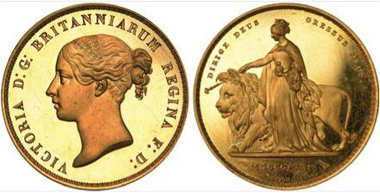21-09-2017 – 22-09-2017
Coinex auctions
New World Record for British Five Pounds Coins
Baldwin’s joint venture with Baldwin’s of St. James’s has resulted in a most successful outcome with their Coinex auctions on 22-23 September 2017 achieving almost £3m coming from the sale of one of Britain’s most beautiful and iconic coins setting a new British record.
Victoria proof 5 pounds, 1839. Estimate: £150,000. Realised: £340,000.
The auction room was full for the duration of the session and the bidders of the room were joined by over 150 hopeful bidders online. The highlight of the day came towards the middle of the session when a Victoria, proof five pounds, 1839, commonly known as ‘Una and the lion’, garnered bids from both the room, over the phone and online. After some intense bidding to start with, it was eventually wheedled down to just two bidders, who went toe-to-toe for at least five minutes before the hammer finally came down on a price of £340,000. The realised price was more than double the original estimate of £150,000 and a New World Record for a British five pounds piece.
This coin was struck as part of the first coin issue of Queen Victoria in 1838, shortly after she had come to the throne. The obverse displays the famous young head portrait of Victoria by William Wyon while the reverse portrays her as Una leading the lion. This coin is not only very rare but is particularly in good condition.
The story is familiar, the mythical tale it is based on is ancient, but here we see a c lassic, exquisitely produced golden rarity whose origins and emblematic significance certainly bear repeating. In the Elizabethan epic poem by Edmund Spenser, the legend of The Faerie Queene was born. Ethereal Una, companion of the Redcrosse Knight in Book One of the allegorical poem, captivated readers’ imaginations for generations: she was more of the spirit than of the flesh, a delicate lady whose knight protected her virtue and her being with undying loyalty. Una was young, untried, innocent but majestic. Two centuries after the poem appeared, a new age in England evolved, and to the poets and adventurers of the Romantic Age no image had more appeal or offered more inspiration than did the mythical Una, who seemed so much like the new Queen Victoria, for she, too, was young, untried, innocent and majestic.
At the Royal Mint, recently situated outside the ancient fortress on Tower Hill, the greatly talented engraver William Wyon sought to capture the public’s imagination and its loyalty to the young Victoria by working to create an image that would endure the ages. By so doing, he also secured his own position, for who could doubt the mastery of the largest gold coin appearing in Victoria’s coronation coin set of 1839? Not only was his sensitive portrait of the young queen lifelike and most beautiful, but his image of ‘Una’ leading the British lion across the Empire and across time itself truly captured the essential spirit of the last years of the Romantic Age, when adventuring ruled the British mind and when the world seemed Britain’s for the taking. Victoria’s ‘little wars’ around the globe were all yet to be played out, and Victoria herself faced the kinds of challenges that no teenager could ever imagine. Over the coming decades, both defeat and triumph would burn into Britain’s collective body politic as the wild escapades of Lord Byron and his contemporaries of the first four decades of the nineteenth century metamorphosed into the realities of conquest and dominion, and as Great Britain reached the zenith of its imperial ambitions.
Considered to be one of Britain’s most beautiful coin, it occurs with two small variant reverse legends, based on Psalm 119:133 and translates as ‘May God Direct My Steps’. William Wyon in 1839 seemed to sense and express the inspiration of the British Empire by the use of this legend, but his image of the queen guiding the British nation, engraved so beautifully on this coin, reflects Britain’s confidence as a world power. Drawing on inspiration from an earlier age, the engraver achieved something few artists ever have – an indelible image of his own times, the Victorian Age.
Here you can visit the website of Baldwin’s.
And here you get to the Baldwin’s of St James’s website.





